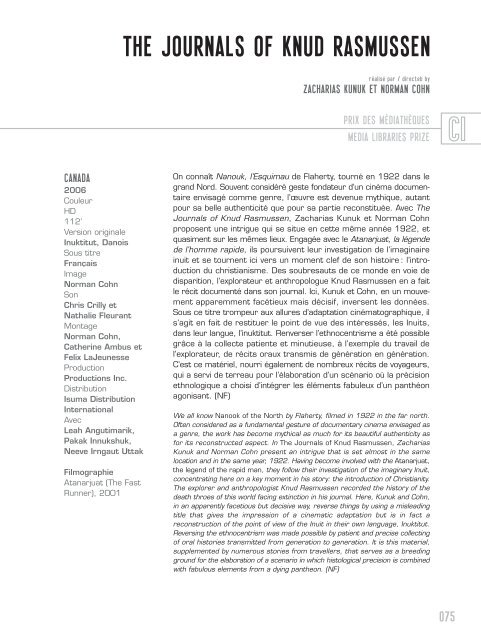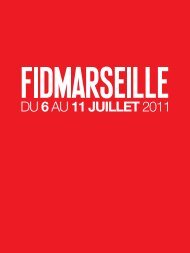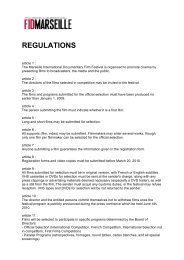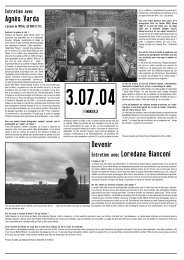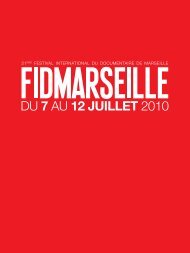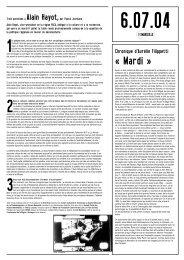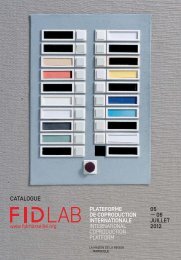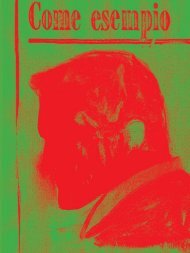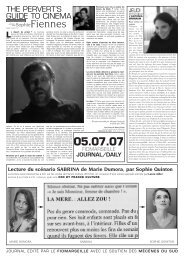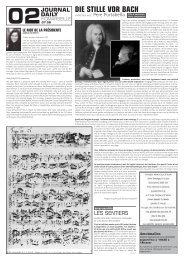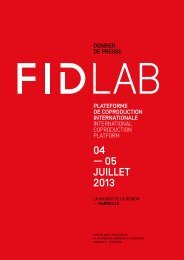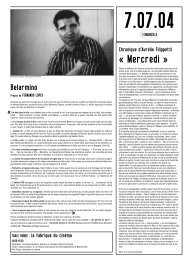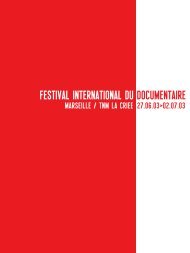catalogue 2007 en .pdf - Festival international du documentaire de ...
catalogue 2007 en .pdf - Festival international du documentaire de ...
catalogue 2007 en .pdf - Festival international du documentaire de ...
Create successful ePaper yourself
Turn your PDF publications into a flip-book with our unique Google optimized e-Paper software.
THE JOURNALS OF KNUD RASMUSSENRETURN OF THE POET / LE RETOUR DU POÈTEréalisé par / directeb byZACHARIAS KUNUK ET NORMAN COHNPRIX DES MÉDIATHÈQUESMEDIA LIBRARIES PRIZECICANADA2006CouleurHD112’Version originaleInuktitut, DanoisSous titreFrançaisImageNorman CohnSonChris Crilly etNathalie FleurantMontageNorman Cohn,Catherine Ambus etFelix LaJeunessePro<strong>du</strong>ctionPro<strong>du</strong>ctions Inc.DistributionIsuma DistributionInternationalAvecLeah Angutimarik,Pakak Innukshuk,Neeve Irngaut UttakFilmographieAtanarjuat (The FastRunner), 2001On connaît Nanouk, l’Esquimau <strong>de</strong> Flaherty, tourné <strong>en</strong> 1922 dans legrand Nord. Souv<strong>en</strong>t considéré geste fondateur d’un cinéma docum<strong>en</strong>taire<strong>en</strong>visagé comme g<strong>en</strong>re, l’œuvre est <strong>de</strong>v<strong>en</strong>ue mythique, autantpour sa belle auth<strong>en</strong>ticité que pour sa partie reconstituée. Avec TheJournals of Knud Rasmuss<strong>en</strong>, Zacharias Kunuk et Norman Cohnpropos<strong>en</strong>t une intrigue qui se situe <strong>en</strong> cette même année 1922, etquasim<strong>en</strong>t sur les mêmes lieux. Engagée avec le Atanarjuat, la lég<strong>en</strong><strong>de</strong><strong>de</strong> l’homme rapi<strong>de</strong>, ils poursuiv<strong>en</strong>t leur investigation <strong>de</strong> l’imaginaireinuit et se tourn<strong>en</strong>t ici vers un mom<strong>en</strong>t clef <strong>de</strong> son histoire : l’intro<strong>du</strong>ction<strong>du</strong> christianisme. Des soubresauts <strong>de</strong> ce mon<strong>de</strong> <strong>en</strong> voie <strong>de</strong>disparition, l’explorateur et anthropologue Knud Rasmuss<strong>en</strong> <strong>en</strong> a faitle récit docum<strong>en</strong>té dans son journal. Ici, Kunuk et Cohn, <strong>en</strong> un mouvem<strong>en</strong>tapparemm<strong>en</strong>t facétieux mais décisif, invers<strong>en</strong>t les données.Sous ce titre trompeur aux allures d’adaptation cinématographique, ils’agit <strong>en</strong> fait <strong>de</strong> restituer le point <strong>de</strong> vue <strong>de</strong>s intéressés, les Inuits,dans leur langue, l’inuktitut. R<strong>en</strong>verser l’ethnoc<strong>en</strong>trisme a été possiblegrâce à la collecte pati<strong>en</strong>te et minutieuse, à l’exemple <strong>du</strong> travail <strong>de</strong>l’explorateur, <strong>de</strong> récits oraux transmis <strong>de</strong> génération <strong>en</strong> génération.C’est ce matériel, nourri égalem<strong>en</strong>t <strong>de</strong> nombreux récits <strong>de</strong> voyageurs,qui a servi <strong>de</strong> terreau pour l’élaboration d’un scénario où la précisionethnologique a choisi d’intégrer les élém<strong>en</strong>ts fabuleux d’un panthéonagonisant. (NF)We all know Nanook of the North by Flaherty, filmed in 1922 in the far north.Oft<strong>en</strong> consi<strong>de</strong>red as a fundam<strong>en</strong>tal gesture of docum<strong>en</strong>tary cinema <strong>en</strong>visaged asa g<strong>en</strong>re, the work has become mythical as much for its beautiful auth<strong>en</strong>ticity asfor its reconstructed aspect. In The Journals of Knud Rasmuss<strong>en</strong>, ZachariasKunuk and Norman Cohn pres<strong>en</strong>t an intrigue that is set almost in the samelocation and in the same year, 1922. Having become involved with the Atanarjuat,the leg<strong>en</strong>d of the rapid man, they follow their investigation of the imaginary Inuit,conc<strong>en</strong>trating here on a key mom<strong>en</strong>t in his story: the intro<strong>du</strong>ction of Christianity.The explorer and anthropologist Knud Rasmuss<strong>en</strong> recor<strong>de</strong>d the history of the<strong>de</strong>ath throes of this world facing extinction in his journal. Here, Kunuk and Cohn,in an appar<strong>en</strong>tly facetious but <strong>de</strong>cisive way, reverse things by using a misleadingtitle that gives the impression of a cinematic adaptation but is in fact areconstruction of the point of view of the Inuit in their own language, Inuktitut.Reversing the ethnoc<strong>en</strong>trism was ma<strong>de</strong> possible by pati<strong>en</strong>t and precise collectingof oral histories transmitted from g<strong>en</strong>eration to g<strong>en</strong>eration. It is this material,supplem<strong>en</strong>ted by numerous stories from travellers, that serves as a breedingground for the elaboration of a sc<strong>en</strong>ario in which histological precision is combinedwith fabulous elem<strong>en</strong>ts from a dying pantheon. (NF)075


